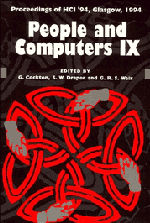Book contents
- Frontmatter
- Contents
- Preface: HCI'94 – You Probably Haven't Seen It All Before
- Part I Invited Papers
- Part II Methodology of Interactive Systems Development
- Crafting Interaction: Styles, Metaphors, Modalities and Agents
- Modelling Humans, Computers and their Interaction
- Notations and Tools for Design
- Part VI Computer-Supported Cooperative Work
- 27 Designing a User Interface for Folding Editors to Support Collaborative Work
- 28 Collaborative Use of X-Windows Applications in Observational Astronomy
- 29 Que Sera Sera — The Problem of the Future Perfect in Open and Cooperative Systems
- 30 Viewpoints, Actionpoints and Spatial Frames for Collaborative User Interfaces
- Author Index
- Keyword Index
28 - Collaborative Use of X-Windows Applications in Observational Astronomy
Published online by Cambridge University Press: 04 August 2010
- Frontmatter
- Contents
- Preface: HCI'94 – You Probably Haven't Seen It All Before
- Part I Invited Papers
- Part II Methodology of Interactive Systems Development
- Crafting Interaction: Styles, Metaphors, Modalities and Agents
- Modelling Humans, Computers and their Interaction
- Notations and Tools for Design
- Part VI Computer-Supported Cooperative Work
- 27 Designing a User Interface for Folding Editors to Support Collaborative Work
- 28 Collaborative Use of X-Windows Applications in Observational Astronomy
- 29 Que Sera Sera — The Problem of the Future Perfect in Open and Cooperative Systems
- 30 Viewpoints, Actionpoints and Spatial Frames for Collaborative User Interfaces
- Author Index
- Keyword Index
Summary
This paper describes a case study in the design and prototyping of a system to support shared use of application programs in an X Windows environment. The primary aim was to satisfy the requirements for remote observation at Royal Observatory Edinburgh. The starting point for the software development was an existing tool ‘Shared-X’, developed to support window-sharing in X Windows. The paper describes the analysis of requirements for safe and efficient shared control in the remote observing situation. Previous work in groupware and application sharing is reviewed, and the architecture for the target system is related to existing taxonomies. The modifications that were necessary to the Shared X tool are described, in particular an improved and extended mechanism for floor control, which was found to be an important factor in the acceptability and usability of the system in the target domain. However limitations in the underlying X Windows architecture and having no access to the shared X source code prevented full implementation of the specification for shared telepointers. In conclusion the work highlights the importance of key issues in collaborative system design, including the importance of flexible and transparent mechanisms for floor control, the effective representation of status and control information in the user interface, the need for appropriate support mechanisms in the underlying window system (e.g. for multiple telepointers), and the increased complexity of evaluation with collaborative as opposed to single-user systems.
Keywords: computer-supported cooperative work (CSCW), groupware, realtime conferencing, shared window servers, Shared X.
Shared Observation
The requirements for this study arose in the application domain of observational astronomy.
- Type
- Chapter
- Information
- People and Computers , pp. 383 - 396Publisher: Cambridge University PressPrint publication year: 1994

